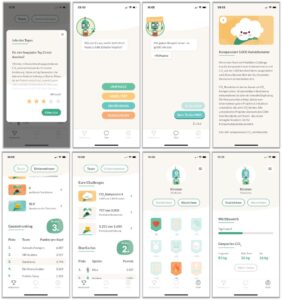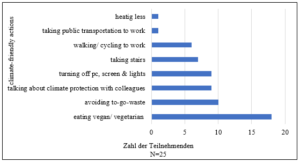How chatbots promote sustainable behaviour in the workplace
Chatbots are a promising technology to playfully promote climate-friendly behaviour of employees at the workplace. This is shown by a first field test of the iOS and Android prototype “KlimaKarl”.
Environmental and climate protection are central challenges of our time. The UN recognises the existential importance of these challenges within the framework of the 2030 Agenda, of which the 17 Sustainable Development Goals form the core (UN 2015). In business, recent years have been decisively marked by advances in innovative digital technologies (e.g., Acemoglu and Restrepo 2018). With little time left to achieve the SDGs by 2030, businesses should harness the disruptive potential of digital technologies to meet their social responsibilities. One promising technology that has attracted much attention in practice and academia in recent years is chatbots.
Chatbots change behaviour
Today, chatbots are used in various business areas. In internal communication with the workforce, practitioners see internal/external support, human resources, purchasing/sales, maintenance, self-service, employee training and knowledge management as promising areas, according to a recent interview study by Meyer von Wolff et al. (2019) (e.g. Kowalski et al. 2013, Piyatumrong et al. 2018, Zumstein and Hundertmark 2017). Due to their interactive and communicative character (cf. Brandtzaeg and Følstad 2017), chatbots in the context of employee training also seem particularly suitable for informing about sustainability and motivating corresponding behavioural changes. However, the use of chatbots to promote sustainable employee behaviour is largely unexplored. There are isolated chatbots to support environmental education, e.g. AluxBot for school children (cf. Peniche-Avilés et al. 2016) or to promote sustainable mobility behaviour (cf. Diederich et al. 2019) – but not in a professional context. We wanted to change this and developed a corresponding prototype called KlimaKarl with the mission of promoting “green employee behaviour” (Fraunhofer IAO 2014) at the workplace.
Interdisciplinary development
To develop a prototype of our KlimaKarl chatbot, we conducted a typical design science research project (cf. Gregor and Hevner 2013, Peffers et al. 2007). In order to determine the concrete requirements for the design and the functionalities of the chatbot, we considered different perspectives from research, the market, the customer and the user in a four-step process. In another three steps, we worked in an interdisciplinary group consisting of the project initiators, a developer and company representatives to break down the multitude of suggestions and ideas into 20 core requirements for the prototype, see Figure 1.

Fig. 1: Selection of requirements and functionalities
We developed KlimaKarl as an iOS and Android app. For this purpose, we used the Google Flutter framework to implement the frontend and the Express framework for the backend. Figure 2 shows a selection of screenshots of the app.

Fig. 2: Screenshots of the app KlimaKarl
Who saves moreCO2?
For evaluation purposes, we field-tested the KlimaKarl prototype in September 2020 in cooperation with two companies and 74 employees to investigate whether the artefact is practicable in a corporate context. KlimaKarl was tested in the context of a CO2-saving competition. In addition to the chat function, the app also contains various gamification elements. In the context of the competition:
- the employees entered completed tasks via buttons in the chat and received direct feedback on the points achieved or the CO2 avoided,
- they took part in a staff survey twice,
- they received and rated daily tips with stars,
- they could achieve team challenges and trigger various donations,
- they were able to unlock badges for repeated tasks, and
- they received an overview of their ranking and statistics in the company, team and user dashboards.
At the end of the competition, the winning team was announced by publishing the ranking list and a newsletter to all participants. To test whether the participating employees behaved in a more climate-friendly way while using the prototype, we asked them (in addition to questions about usability and intention for long-term behaviour change) to indicate whether they performed certain climate-friendly tasks – such as eating vegan lunch, cycling to work, turning off lights, etc. – more often than before the competition. – more often than before the competition. The figure summarises the results in the form of a histogram with absolute numbers. According to this, e.g. 18 out of 25 respondents (72%) ate vegan or vegetarian more often during the use of KlimaKarl than before (Fig. 3).

Fig. 3: Results during the use of the prototype
Conclusion and next steps
The results of the first evaluation are encouraging and show that the prototype is rather user-friendly and can motivate people to adopt more climate-friendly behaviour. In future steps, we plan to expand the functionalities of the chatbot and evaluate it in a more differentiated way. After a corresponding revision, we want to make the chatbot available for Swiss and German companies in autumn 2021. Depending on how KlimaKarl is received in practice, we are looking forward to translating the app into other languages and launching it internationally.
References
- Acemoglu, D., Restrepo, P.: Artificial intelligence, automation and work (No. w24196). National Bureau of Economic Research (2018).
- Brandtzaeg, P. B., Følstad, A.: Why People Use Chatbots. In: 4th International Conference on Internet Science, Springer, p. 377-392, Cham (2017).
- Diederich, S., Lichtenberg, S., Brendel, A. B., Trang, S.: Promoting sustainable mobility beliefs with persuasive and anthropomorphic design: insights from an experiment with a conversational agent. International Conference on Information Systems (ICIS). Munich, Israel (2019).
- Fraunhofer IAO: Green Office (2014).
- Gregor, S., Hevner, A. R.: Positioning and presenting design science research for maximum impact. MIS quarterly, 337-355 (2013).
- Kowalski, S., Pavlovska, K., Goldstein, M.: Two Case Studies in Using Chatbots for Security Training. In: In Information Assurance and Security Education and Training, pp. 265-272. Springer, Berlin (2013).
- Meyer von Wolff, R., Masuch, K., Hobert, S., Schumann, M.: What Do You Need Today?-An Empirical Systematization of Application Areas for Chatbots at Digital Workplaces (2019).
- Peffers, K., Tuunanen, T., Rothenberger, M. A., Chatterjee, S.: A design science research methodology for information systems research. Journal of Management Information Systems, 24(3), 45-77 (2007).
- Peniche-Avilés, J., Miranda-Palma, C., Narváez-Díaz, L., Llanes-Castro, E.: AluxBot-A Chatbot that Encourages the Care for the Environment.” International Journal of Computer Science Issues (IJCSI) 13(6), 120 (2016).
- Piyatumrong, A., Sangkeettrakarn, C., Witdumrong, S., Cherdgone, J.: Chatbot Technology Adaptation to Reduce the Information Gap in R&D Center: A Case Study of an IT Research Organization. International Conference on Management of Engineering and Technology (PICMET), pp. 1-9. Portland, USA (2018).
- United Nations (UN): The 2030 Agenda, https://www.un.org/ga/search/view_doc.asp?symbol=A/RES/70/1&Lang=E, last accessed 2021/04/11.
- Zumstein, D., Hundertmark, S.: Chatbots – An interactive technology for personalized communication transactions and services. IADIS International Journal on Internet, 15(1) (2017).
About the study
The study has been published in open access by SSRN.
16. DESRIST Conference
The study will be presented at the16th DESRIST International Conference on Design Science Research. The conference is currently taking place at the University of Agder, Kristiansand, Norway until 6 August. Contributions around the topic of socio-technical design will be presented and discussed. All information can be found here.
 Create PDF
Create PDF



 Contributions as RSS
Contributions as RSS Comments as RSS
Comments as RSS
Leave a Reply
Want to join the discussion?Feel free to contribute!